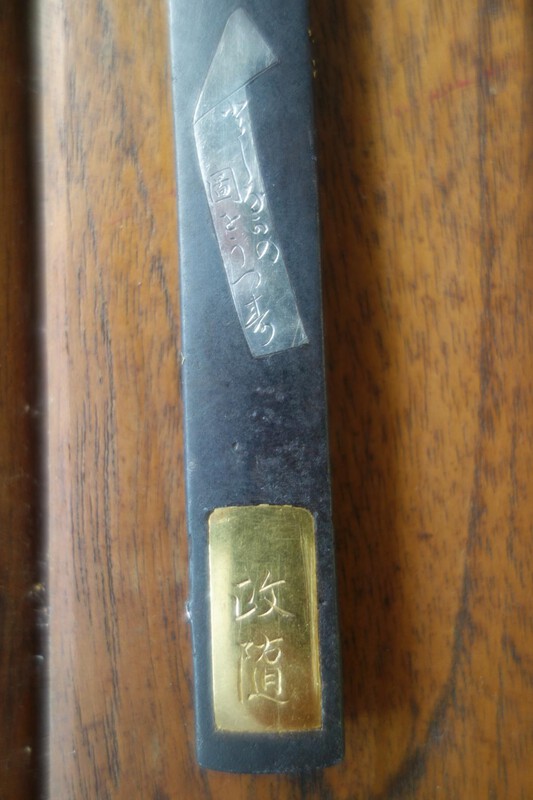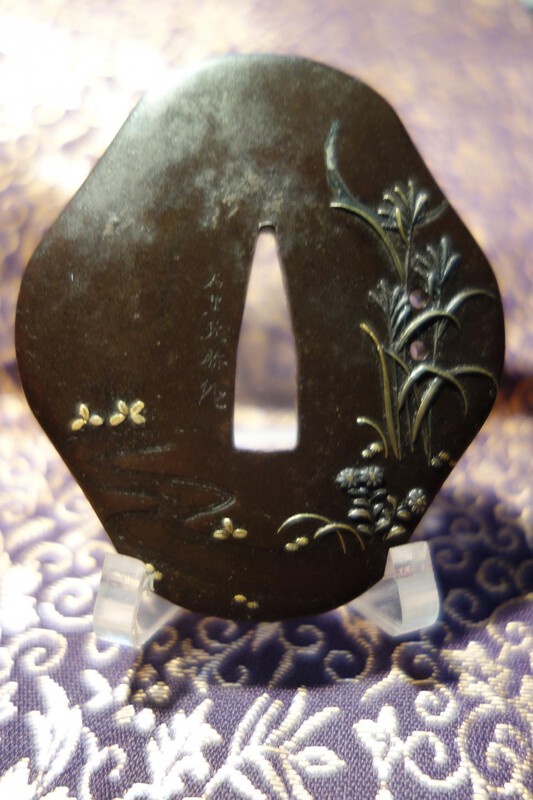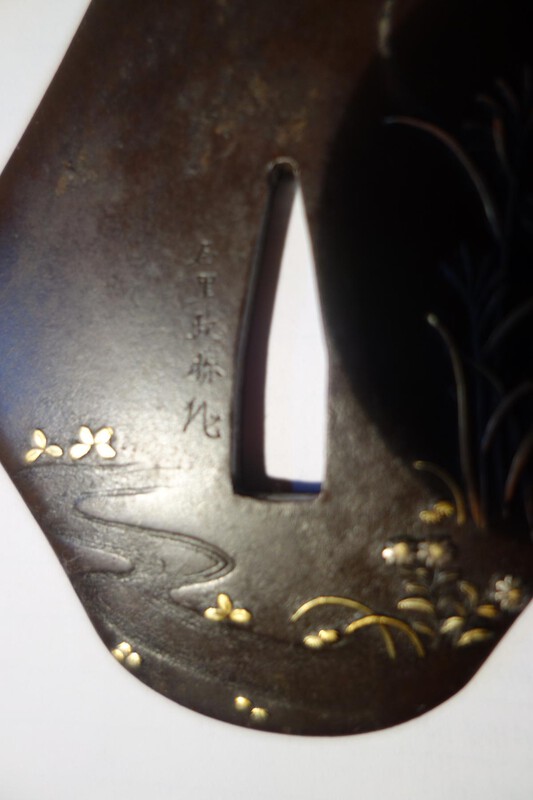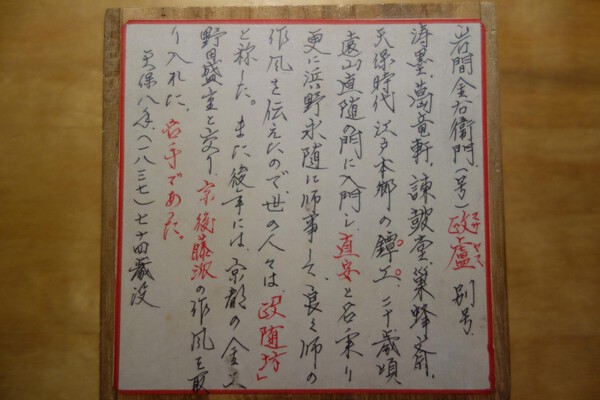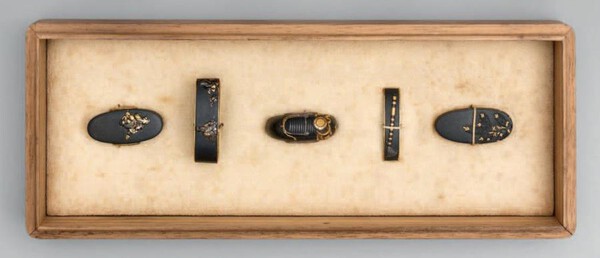-
Posts
1,370 -
Joined
-
Last visited
-
Days Won
3
Content Type
Profiles
Forums
Events
Store
Downloads
Gallery
Everything posted by Kurikata
-
Pete, I would like to warmly thank you on this very precious information.....Once again your participation to this forum is an asset. Best regards Bruno
-
Thank you Marius for your comments. Can you give me the clues which drive to an late Edo Kozuka? Is it coming from the "fresh" gunome zogan on the fruits, the nanako patern, the shakudo color and texture, others .... ? Thank you any way for you advises which are always very instructive. Best regards Bruno
-
Hi, I just purchased this Kozuka this week. I guess it could be a shakudo Ko kinko Kozuka which has been repaired end of Edo with an additional silver and sentoku plates. What are you views in this ? Thank you in advance Bruno
-
Hello, Can someone translate the poem which is back the Kozuka? It is signed Masayuki. Is it Gimei ? Topic is Jurojin with his scroll, crane and tortoise. Thank your for your help. Bruno
-
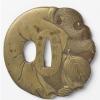
New Acquisition Late Edo Period Tanto
Kurikata replied to DigsFossils-n-Knives's topic in General Nihonto Related Discussion
Hi Henry, Mon on the saya is : Wisteria (Fuji, 藤) One of the Family using this Mon was the Fujiwara Clan: http://en.wikipedia.org/wiki/Fujiwara_clan Regards -
Jean, I have one in my collection. Very simple, with black lacquer but very late Edo or even beginning of 20th century to me.
-
Denis, Price looks quite in the right range. Just to confirm that shells, abalone or clams theme is not that unusual within the Kinai school, but not the way yours has been designed... Please refer to: http://jameelcentre.ashmolean.org/collection/7/10237/10354 Best regards
-
It is a very common echizen kinai tsuba........
-
Dear All, by any chance, can some one help ? Thank you in advance. Bruno
-
-
Hi, the name is Udenuki Ana. please refer to this site which provides all names in Japanese: http://www.jssus.org/nkp/kanji_for_tsuba.html best regards
-
-
Michael, A lot of knives, spoon ans forks sets have been exported from Japan to Europe beginning of 20th century with handles copying both sides kozuka design. These handles are generally in plain Copper or shinchu with no inlays. Should you have pictures, it would confirm.
-
@ Geraint , it is absolutly true. The shinchu plate is incrustred into a large iron Mimi. This schinchu plate is cut itself to include a HoHo bird in iron. @Brian, Thank you for your so gentle comment. Cheers
-
-
Would it be Masayoshi (Iwama Masayoshi, 1764-1837) as Tsuba-Ko and not Masayasu?
-
Thank you Chris Do you mean that the Tsuba is dated 1837 or the Hakogaki has been written in 1837? Do we have some clues on the Tsuba-ko ? Thank you again
-
-
Hi Hames one 's more. I am in. Cheers Bruno
-
Among kyo Kinko schools, coudl itbe Goto, Otsuki or Ichinomya? Thank you for your input Bruno
-
-
I would guess early Edo (end of 17th century)
-
Looks like a Sanmai Awase style tsuba too me (do you confirm that three plates are held together by a border ?) .
-
Thank you again Morita San. I did not know that this set was made by such a well known craftman (even if the work is excellent with a very skillfull nanako). Do you know who has written this Hakogaki ? I discovered thanks to you, an article from the NBTKK journal from November 2014 about Aoki Harutsura (written by Kubo Yasuko): Among the Otsuki school smiths, there are excellent smiths, and among them were Kawasaki Kagaharu and Aoki Shunkan(Harutsura). Both Kagaharu and Shunkan were gifted craftsmen, but they passed away at an early age, just like a shooting star. This work is Shunkan’s menuki. In Bunka 2, Shunkan was born and was a son of the kozuka smith Yamashiroya Jinsuke. According to the historical book “Tagane no Hana” he was a genius and had no regular teacher, but some people said he was a student of Kawasaki Kagaharu, although the details are uncertain. Other sources said he was consultant or advisor to master smiths such as Uesugi Kazutsura and Goto Ichijo.” Considering his birth, he naturally learned from his father and continued with his father’s tradition, but after that, his history is uncertain. He was Kazutsura’s age, and they were close each other, so it is hard to think about them as a teacher and student. Also, Kagaharu has very few works left today, and it is hard to judge from their work if there was a teacher and student relationship. Concerning Ichijo, there is no clear evidence of any association between them. So, there is no evidence to support the idea that there was someone who was a formal teacher to him. Looking at Shunkan’s work today, there is no question that he was a genius. In particular, his designs, selective eye, expressive techniques, and his human figures are amazing. Looking at his work, of which not many were produced, he choose subjects such as God, Buddha, Chinese legends, the Genpei battles, No theater, and Japanese traditonal Tokei events like that seen on these menuki, (tokei were imperial court events held in March, and the tradition began in the Heian period). He chose subjects from his cultural background, and expressed them very well. His human expressions show smooth muscular movements in the forehead, cheek, or even the ears, and nervous expressions, not only in the face, but also in the hands and feet. There are elegant movements in clothing, soft shapes in the eboshi (men’s formal hats). Also, in the cocks flowing feathers and tail, he used very delicate chisel marks, abundant irogane (inlays) such as okigane (inlay), and hirazogan (high relief) ,and this kind of work tells us he was not an ordinarily skilled smith. This entire work has an elegant feeling. On the back, the menuki workmanship is perfect. There is a large chikara-gane (reinforcement), the bottom is firm, the tanzaku (plate for mei) is neat, the kanji signature begins and ends with strong dots with Shunkan’s original character and was very carefully done. I feel, this is an exemplary and the best work, and I could enjoy a glimpse of Shunkan’s world. At the same time, from this work, we can recognize again the Kyoto kinko smiths great and skillfull ability. Cheers Bruno
-
Hi Japanese members (or gaijin experts), I know that I am taking too much of your time to translate those Hakogaki. But what a source of infomation ! Can you help me another time ? Thank you





